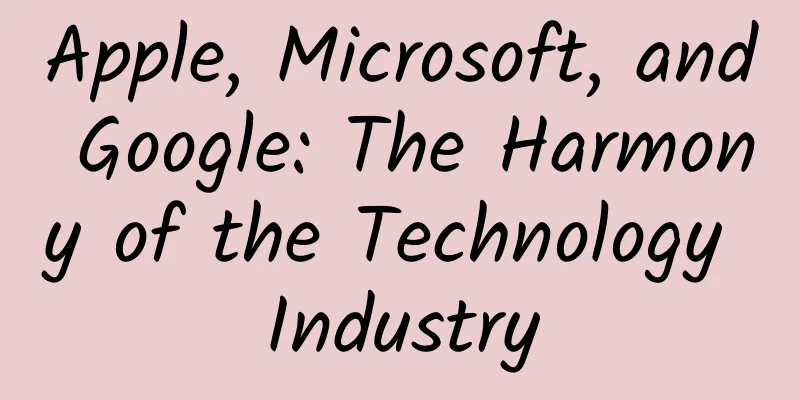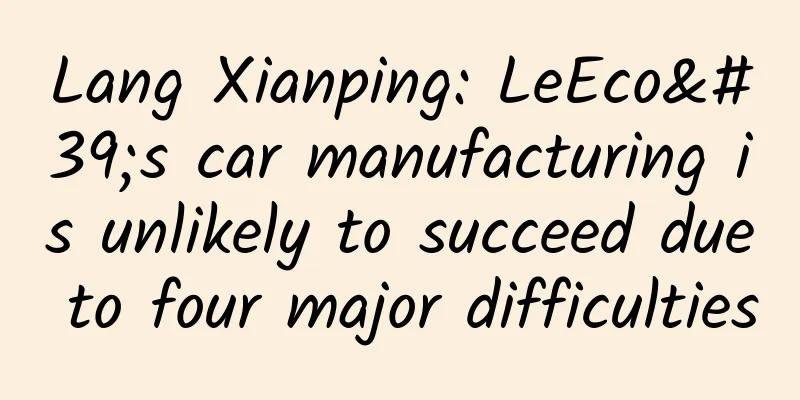Apple, Microsoft, and Google: The Harmony of the Technology Industry

|
Microsoft Build, Google I/O, and Apple WWDC are the most influential developer events in the current technology industry. They are the vanes of enterprise and industry development, conveying the current and future development trends. But summarizing the development and changes shown by the three giants at the developer conferences in the past two years, we found that: in this round of "muscle show and future show", the contention of a hundred schools of thought is decreasing, and the world is becoming more and more united. In the past two years, the developer conferences of the three giants have jointly demonstrated the development trend of "mutual reference in experience functions, mutual penetration of development concepts, and increasingly similar future development directions" that the technology industry is experiencing. Perhaps, the world of unity in the technology industry will be just around the corner. 1. Mutual Learning in Function and Experience Picasso once said: "Good artists copy, great artists steal", this sentence also applies to the technology industry. Looking back at the developer conferences of the three technology giants, this sentence is even more obvious. The three giants "steal" the excellent features of their competitors' operating systems in their own systems. Take this year's developer conference as an example. Microsoft borrowed more touchpad gestures from Apple on Windows 10, and allowed Android and iOS applications to reuse code to create Windows 10 mobile applications to solve the mobile dilemma. Google borrowed application security mechanisms from Apple and Microsoft on Android M and launched Android Pay, which imitates Apple's mobile payment Apple Pay. Apple also borrowed the split-screen function launched by Microsoft on Windows 8 on its latest OS X El Capitan and iOS 9, and borrowed Google's "public transportation information, news client, wearable function and Android desktop; and Apple's innovation of Siri's functions borrowed the excellent functions of Microsoft's Cortana and Google Now at the same time. It can be seen that taking the essence and sharing what is needed, learning from and absorbing the advanced functions of other platforms for our own use, in order to enhance and perfect the usability of our own operating systems and bring better user experience, is the main theme of the three major developer conferences on the improvement of operating systems. The three giants seem to be moving towards the direction of unification of system functions. 2. Mutual Penetration of Development Concepts The three developer conferences of the three giants not only exchanged what they had in system functions, but also shared their development concepts. In the choices of the current and future development of applications, development languages, and operating systems, the three giants seemed to have reached the same conclusion. 1. Full-platform strategy for applications In terms of mobile applications, the three giants that were open in the PC era seem to have been closed in the mobile Internet era. Microsoft and Apple used to build high barriers and did not open their own applications to the outside world. But when Microsoft accepted the fact that it was lagging behind in the mobile Internet era, and Apple realized that Google's use of its own applications to recreate the "Android system" on the iPhone and quickly change the internal Android system may repeat the victory of PC over Mac. All companies responded quickly and implemented the full-platform strategy of applications. Microsoft quickly learned from Google (and was more open than Google in opening up its own applications) and turned its heavyweight applications such as Office, Skype, OneNote, the entire MSN series (health, weather, Outlook, information, Bing), OneDrive, Office lens, Office Remote, Microsoft Health, etc. into full-platform applications, and pushed them all to iPad, iPhone and Android platforms, in the hope of recreating a "Windows" for the mobile Internet era on these two platforms. Google, which was the first to open up, will naturally not lag behind in this strategy. The latest Google Photos application launched at this conference also supports iOS and Windows systems. Apple, the most closed, also showed a rare openness at this developer conference, pushing its latest streaming music application Apple Music to the Windows platform and Google Android system. It can be seen that in the choice between openness and closure, the three giants seem to have embarked on the road of openness and are aiming at the full-platform strategy. 2. Development languages embrace open source strategy The three giants aim at the full-platform strategy in application, and have enthusiastically embraced open source in development language. Google's Go language is needless to say; Microsoft, which once regarded open source technology as a cancer, also put up the slogan "Microsoft loves Linux" under Nadella's leadership, and announced support for Docker and the open source of .NET; and Apple also announced at the WWDC 2015 conference that it would open source the Swift language it developed. The three giants have chosen to embrace open source, hoping to make their own languages have more usage advantages, and use the power of the public to improve and add new features, discover and fix new vulnerabilities. 3. Unified strategy of operating system The mutual penetration of development concepts is not only reflected in the full-platform strategy of applications, nor is it just the embrace of open source development languages. In addition, each company is using its superior operating system to revitalize its own weak platform and make its own scattered operating system move towards a unified path. (This trend was even more obvious in the 2014 Big Three Developer Conference system) In the past two years, Microsoft has combined the original Windows 8 Pro, Windows 8 RT and Windows Phone 8 operating systems into one, launching the new Windows 10, which spans across PCs, mobile devices and the future Internet of Things. By taking advantage of its unprecedentedly broad cross-terminal nature, it has completed its long-planned cross-terminal unification strategy. It also uses the unification feature of Windows 10 to quickly increase the imagination of the Windows ecosystem, help the prosperity of the Windows mobile application ecosystem, and revitalize Microsoft's weak mobile competitiveness. Google uses Android to revitalize its own Chrome OS operating system, allowing Android applications to run on many Chrome OS, so as to take advantage of Android's ecological advantages to enhance the competitiveness of Chrome OS, hoping to replace Windows one day. Apple, on the other hand, has launched the Continuity function to allow its own iOS system and OS X to develop system-level synergy. In the process of continuous development and evolution, the trend of integration and unification of Google's Android and Chrome OS, and Apple's iOS and OS X operating systems has become increasingly obvious. The full platform of applications, the embrace of open source development languages, and the integration of systems show the mutual appreciation of the three giants in development concepts. However, coincidentally, in the pursuit and grasp of the next wave of technological revolution, the three giants seem to have coincidentally hit the same pulse of future technological development. 3. The future development direction is increasingly converging Grasping the pulse of future technological development and the potential areas of the next wave of technological revolution, both the three giants Microsoft, Google, and Apple as well as other technology companies have set their sights on the development potential of artificial intelligence, AR/VR technology, the Internet of Things, wearable devices, mobile digital health care, and in-vehicle systems. The three giants are making intensive arrangements in these areas. 1. In artificial intelligence: The three giants are all working hard to develop their own artificial intelligence products, and Google's Google Now, Microsoft's Cortana, and Apple's Siri are artificial intelligence products that we have already come into contact with and are using on a large scale. 2. In AR/VR technology: Although Google experienced the Waterloo of Google Class, it later launched Cardboard; Microsoft launched the stunning black technology HoloLens. Although Apple has not been moved and has not launched related products, its acquisition of German augmented reality (AR) software company Metaio and other actions also show that it is secretly accumulating strength. 3. On the Internet of Things: Microsoft, Google, and Apple all have their own strategic deployments. Microsoft relies on the unification of Windwos 10, using Windows 10, devices (mobile devices, IoT devices) and Azure cloud service platform to build Windows 10 for IoT suitable for the Internet of Things. Google officially launched Project IoT at the I/O 2015 conference, using Google Cloud Services and Google's massive Android smartphone market share as its most competitive weapons, allowing it to serve as the core link on the Project Brillo IoT platform and the connector on the Google Weave side. Apple relies on the iOS system and HealthKit, HomeKit APIs, using iOS devices and cooperating with third-party smart home products or wearable device manufacturers to build its own IoT ecosystem. 4. Wearable devices: Google launched the Android Wear operating system platform, continuing to copy the growth path of Android on the basis of tightening permissions, and Moto 360 is the representative work of this platform. Apple launched the Watch OS operating system and launched the Apple Watch smartwatch; Microsoft did not choose a smartwatch, but instead chose a smart bracelet and launched the Microsoft Band health bracelet. 5. In the field of mobile digital health: The three companies have also made their own moves. Apple launched the HealthKit health application in 2014, and continued to add new features in 2015, launching ResearchKit and cooperating with many world-class medical institutions. Google and Microsoft are also not lagging behind in this health battle. Google launched the digital health management platform application Google Fit, and Microsoft launched the cross-platform Microsoft Health. 6. In-car system: The three giants seem to have come up with the same idea when it comes to car transformation. They have released their own in-car systems, Apple launched Car Play, Google launched Android Auto, and Microsoft also has its own solution. In terms of autonomous driving, Google is the most eye-catching, but Apple and Microsoft also have related news from time to time. Conclusion: With the development of science and technology, various platforms have shown a trend of "mutual reference of experience functions, mutual penetration of development concepts, and increasingly similar future development directions". Perhaps one day in the near future, the various barriers between operating systems will be broken. At that time, no matter which platform consumers choose, they can get a consistent user experience. The system experience of Windows Phone, Android, and iOS will be the same. This seems to be announcing the disappearance of differentiation, but we don't have to feel sad about it, and we can't judge that technological innovation has reached a dead end. We should be excited: because although there is a growing trend of convergence, penetration, and indifference, the competition in the technology industry will not stagnate, but will become more intense. Because in the trend of convergence, the conditions that affect consumer choices will be greatly reduced. In the case of universal harmony, to stand out, we must be meticulous about details, strive for excellence in products, and create new differentiation, and the beneficiaries of all this are us consumers. In the pursuit of the next wave of technology, there are not only the three giants mentioned in this article, but also countless technology companies involved. They are almost all targeting the same field and are secretly working hard. So who will take the lead in the next wave of technological revolution? Who can become the giant of the new era? Who will be eliminated and be beaten to death on the beach? Will there be a rising star who will change the world? This uncertainty in the future will be the most interesting part of the convergent future! |
<<: The Internet is good, but it's getting worse
>>: Interpreting ASP.NET 5 & MVC6 Series (4): Core Technology and Environment Configuration
Recommend
The road to creating a good product: starting with demand to capture the hearts of bosses and users
Product Positioning This is the direction of prod...
Feng Shui selection and layout of shops (Jiang Wenhe)
Jiang Wenhe's "Shop Feng Shui Selection ...
4 Strategies for Affiliate Marketing
Are your members really your members? Regarding a...
Competing against Xiaomi Mi 8, Honor Play claims to have twice the gaming stability as Xiaomi Mi 8, priced at only 2,399 yuan
It’s still the same Mi fans, the same script, and...
Linyi SEO training: Summary of the network promotion plan for building high-quality external links
External links refer to links from other websites...
The frozen crocodile I bought back home came back to life? Is it really not illegal to eat crocodiles?
Recently, a short video went viral on the Interne...
Advanced | A promotion optimizer who spends more than 2 million per month will teach you how to place information flow ads scientifically!
With the vigorous development of mobile communica...
Xiaopeng PR, incomprehensible operations
The self-media "Yikou Laopao" published...
Does "age odor" exist? Do elderly people have a special smell?
Leviathan Press: Many people have probably smelle...
Yongge's 71 video of the money-making project
Introduction Yong Ge’s video tutorials on lucrati...
You're throwing away the most nutritious part of the celery!
Celery is a vegetable that everyone buys at home....
The dilemma facing mobile phone manufacturers in 2019: 5G is coming, should they follow suit or not?
In the mobile phone industry, the battle for 5G i...
After 6 years, the first perfect jailbreak of iOS 14 is released: supports iPhone 12
[[431010]] Since the perfect jailbreak in the iOS...
"Black Squad: Deadly Assault" experience to see what kind of sparks Korea's No. 1 FPS game and LeTV TV create
Why do so many people like to play games with a k...
Is it always better to buy a waterproof phone? You may not be able to afford the increased cost
How important is waterproofing for smartphones? F...









